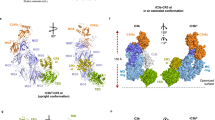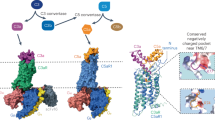Abstract
EVIDENCE from haemolytic systems suggests that complement activation by either the classical or alternative pathways requires a close approximation of critical molecules at the cell surface. At least two molecules of IgG antibody in close proximity are required for the first component of complement to be bound1. Thus when increasing concentrations of IgG are added to erythrocytes in the presence of excess complement, haemolysis is minimal until a critical IgG concentration is reached. In the case of the alternative (properdin) pathway of complement activation, at least two molecules of C3b must be critically orientated together at the cell surface in order for properdin to bind and stabilise C3/C5 convertase2. Thus erythrocytes have a simple mechanism of signal discrimination by which they can ‘count’ the number of molecules reacting with their surfaces. The cells only ‘respond’ by lysis when a critical number has been reached. I present data which relate this mechanism of signal discrimination by erythrocytes to the mechanism by which cultured lymphocytes discriminate between low and high concentrations of the mitogenic lectin concanavalin A (con A). This in turn may be related to the mechanism by which lymphocytes discriminate between low and high concentrations of specific antigen to produce either an immune response or immunological tolerance3.
This is a preview of subscription content, access via your institution
Access options
Subscribe to this journal
Receive 51 print issues and online access
$199.00 per year
only $3.90 per issue
Buy this article
- Purchase on Springer Link
- Instant access to full article PDF
Prices may be subject to local taxes which are calculated during checkout
Similar content being viewed by others
References
Rapp, H. J. & Borsos, T. in Molecular Basis of Complement Action, 71–74 (Appleton-Century-Crofts, New York, 1970).
Medicus, R. G., Schreiber, R. D., Gotze, O. & Muller-Eberhard, H. J. Proc. natn. Acad. Sci. U.S.A. 73, 612–616 (1976).
Forsdyke, D. R. J. theor. Biol. 25, 173–185 (1969).
Milthorp, P. & Forsdyke, D. R. Nature 227, 1351–1352 (1970).
Milthorp, P. & Forsdyke, D. R. Biochem. J. 132, 803–812 (1973).
Gunther, G. R., Wang, J. L., Yahara, I., Cunningham, B. A. & Edelman, G. M. Proc. natn. Acad. Sci. U.S.A. 70, 1012–1016 (1973).
Edelman, G. M. Science 192, 218–226 (1976).
Colten, H. R. Adv. Immun. 22, 67–118 (1976).
Forsdyke, D. R. Biochem. J. 105, 679–684 (1967).
Trowbridge, I. S. Proc. natn. Acad. Sci. U.S.A. 70, 3650–3654 (1973).
Bornens, M., Karsenti, E. & Avrameas, S. Eur. J. Biochem. 65, 61–69 (1976).
Fraser, A. R., Hemperly, J. J., Wang, J. L. & Edelman, G. M. Proc. natn. Acad. Sci. U.S.A. 73, 790–794 (1976).
Beppu, M., Terao, T. & Osawa, T. J. Biochem. 79, 1113–1117 (1976).
Yahara, I. & Edelman, G. M. Proc. natn. Acad. Sci. U.S.A. 72, 1579–1583 (1975).
Sallstrom, J. F. & Alm, G. V. Expl Cell Res. 75, 63–72 (1972).
Storrie, B. J. Cell Biol. 62, 247–252 (1974).
Morse, J. H. Immunology 14, 713–724 (1968).
Anderson, J., Sjoberg, O. & Moller, G. Immunology 23, 637–646 (1972).
Chauvenet, A. R. & Scott, D. W. J. Immun. 114, 470–475 (1975).
Moller, G. Scand. J. Immun. 5, 583–586 (1976).
Wedner, H. J. & Parker, C. W. Prog. Allergy 20, 195–300 (1976).
McClain, D. A. & Edelman, G. M. J. exp. Med. 144, 1494–1508 (1976).
Forsdyke, D. R. in The Biological Effects of Phytohaemagglutinin (ed. Elves, M. W.) 115–123 (R. Jones and A. Hunt Orthopaedic Hospital, Oswestry, 1966).
Forsdyke, D. R. Proc. Can. Fed. Biol. Socs 19, 62 (1976).
Fernandez, S. M. & Berlin, R. D. Nature 264, 411–415 (1976).
Author information
Authors and Affiliations
Rights and permissions
About this article
Cite this article
FORSDYKE, D. Role of receptor aggregation in complement-dependent inhibition of lymphocytes by high concentrations of concanavalin A. Nature 267, 358–360 (1977). https://doi.org/10.1038/267358a0
Received:
Accepted:
Issue Date:
DOI: https://doi.org/10.1038/267358a0
This article is cited by
-
Lymphocyte repertoire selection and intracellular self/non‐self‐discrimination: historical overview
Immunology & Cell Biology (2015)
Comments
By submitting a comment you agree to abide by our Terms and Community Guidelines. If you find something abusive or that does not comply with our terms or guidelines please flag it as inappropriate.



